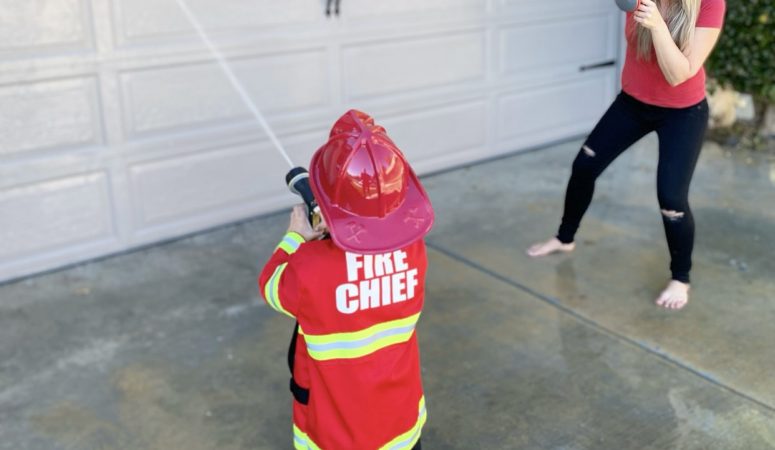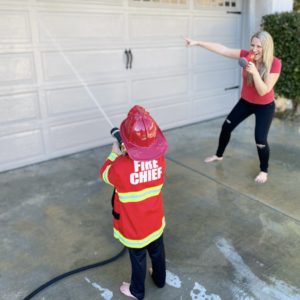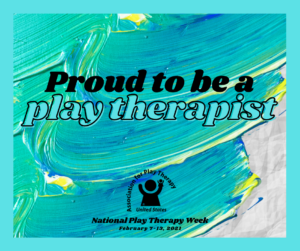It’s National Play Therapy Week and as a nationally recognized Registered Play Therapist and Licensed Marriage and Family Therapist, I want to bring awareness to play this week as it is vitally important for a child’s growth, cognitive and emotional development, and overall mental wellbeing! And now, with the big role the pandemic has played with children’s mental health, play is needed more than ever! I am sure it does not surprise you how much I value the power of play. I am a proud member of the Association for Play Therapy and also teach university level Play Therapy courses to Master’s and Doctoral level students. Play is my expertise and I incorporate into my everyday routine professionally and personally.
Play is so instrumental in helping children build social and emotional skills, relieve stress, build language and communication skills, and learn core strategies on how to take turns, share, and follow directions. Play is also critical for brain growth and allows children the freedom to get lost and discover who they are. Play is a fundamental way for children to express themselves, explore creatively, and use their imagination. Without saying a word, a child can create an imaginary world for themselves and get lost in their own creative space. Play is especially important for a child who doesn’t have the language to express themselves verbally, but can play as a way to communicate and relate to others in their world.
Over the last decade of working with thousands of children with various diagnosis and also with children who don’t have a specific diagnosis, I have found there are certain toys and tools that are most beneficial to play with that I believe every parent and therapist should own! This list of toy tools are ones that ALL children benefit from!
Medical Kit
A medical kit is necessary for many reasons. Every child needs to go to the doctor at some point in their childhood as early as infancy through adolescence. Whether it’s a routine well check, a sick visit, or even a trip to the emergency room to have a procedure or surgery, children need to practice being sick, taking care of others, and desensitize themselves from the fear of going to the doctor. Playing with a medical kit helps foster trust and comfort with going to the doctor and alleviates anxiety and fear of having a shot, being sick, and taking medicine. Here is the one I own that I recommend!
Puppets
Puppets are my favorite play tool. I have used puppets for so many reasons over the years. I have had children who are diagnosed with adjustment disorder, depression, anxiety, autism, or even selective mutism where puppets have helped them therapeutically heal. I have worked with children with trauma, grief and loss, and even those going through a divorce that benefit from puppet play. I even use puppets with my own children, when I teach, and in my parenting workshops. Puppets foster comfort, trust, and communication. Children can talk to a puppet much easier than they can talk to an adult, whether it’s a parent or a therapist. It’s brings a sense of belonging and friendship to children who want someone to talk to with no judgment. Here is a link to a set of puppets I recommend!
Dollhouse
I love the use of a dollhouse at home and in my office. Children love to reenact their home environment and or like to create a new environment with their imagination. Either way, the child can overcome and heal from difficult home situations and or escape and create a more desirable environment that will help them cope with less desirable home environments. Dollhouses also come in very handy when a child lives in two different homes with two sets of parents and siblings. Dollhouses can be expensive, but here is the link to an affordable one that I recommend!
Dress Up Clothes
Children love to use their creativity and imagination to become a firefighter or princess for a day. Through this type of fantasy or symbolic type of play, children can develop a persona that helps them deal with conflict, fears, anxiety, and sadness by dressing up in a costume of some kind. For example, if a child has trouble meeting new children in real life, but then dresses up in a cape and sunglasses, it can make it easier for them to socialize and be in social environments because they have created their own superhero power. Children can also benefit from dressing up when they are trying to learn and practice role playing and pretend play. For example, a child may benefit from dressing up like a firefighter and using a hose to spray down their house to learn a new role or feel empowered and pretend they are a hero for the day! And lastly, children love to have fun and reenact actions from their favorite characters from their favorite shows, life events, theme parks, etc. Here is the link to the Melissa & Doug firefighter costume we own!
Punching Bag
A punching bag is an extremely important play tool to express anxiety and or anger. The mental and physical release of punching the bag externalizes the emotions onto the bag instead of keeping it inside of their body. This way, children can use this as a positive and effective coping mechanism instead of possibly hitting another person like a peer, sibling, or even engaging in self harm. A punching bag also comes in handy for children with ADHD or a child with a tremendous amount of energy that needs a replacement behavior to release their energy. It’s a fun exercise tool, too! Here is the one I own that I recommend!
Sensory Bin
I can’t say enough beneficial things about sensory bins. Sensory bins are helpful for children to learn how to self soothe, familiarize themselves with textures, practice motor skills, and self regulate. Whether it’s filled with play sand, dried rice, water, dried oats, dried beans, dried pasta, or water beads, sensory tables are so much fun! You can make them educational, playful, and themed! I recommend getting a large plastic bin and filling it with a variety of textures and items like pom poms, buttons, feathers, magnetic letters, small puzzle pieces, foam blocks, clothespins, shells, small toys like dinosaurs or cars or insects, miniature construction vehicles, cups, funnels, tongs or a spoon, toilet paper or paper towel roll, and an ice cube tray.
Stuffed Animals
Stuffed animals bring so much love and comfort to children. Stuffed animals can even be a child’s most prized possession or best friend. Stuffed animals can help a child self regulate and even help them sleep better during naps and at bedtime. A child can communicate with their stuffed animal without judgement and receive unconditional love and support from this loyal friend. When a child is sad, hurt, grieving, or mourning, they can cry and express their emotions to their stuffed animal. When a child is happy, they can share all of the good things about their day with their stuffed animal or even take their stuffed animal to explore the world with them, giving them a sense of belonging and social confidence. Stuffed animals can also help children through a life transition like welcoming a new sibling, dealing with a parental divorce, a death of a loved one, or transitioning to a new school. Children love taking their stuffed animals with them to the doctor, on vacation, to school, and to bed at nighttime.
Play Telephone or Mirror
Similar to the puppet, having a play phone gives a child the opportunity to talk to anyone they want, real or imaginary. Playing with a mirror or play telephone helps a child with creativity and expression of self. Maybe a child wants to call a parent that travels a lot or lives in a different home. Or maybe a child wants to call a friend that they moved away from that they miss and just want to say hello. Maybe they want to call an alien or their favorite Disney character and have a conversation with them. Whatever the reason, children can use the phone to talk to someone that they may not be able to talk to in real life. This type of play can also give them the opportunity to tell someone something that might be too hard to say to their face in real life. Children can practice what they want to say to someone in real life by using the mirror or phone first. A mirror can have the same benefit, except, they are able to talk to themselves instead of someone else. It can also help with language and communication skills, too! Here is the one I own that I recommend!
Tent or Tunnel
Children want a space to escape and feel safe. Everyone needs some independence, and especially in these challenging times during the pandemic when all family members are home all day everyday, finding time alone can rare but absolutely vital to better emotional, social, and mental wellbeing. A play tent or tunnel can give your child the autonomy and or safety they desire. It gives them a place to hide if they need it. It gives them a place to self regulate. And it gives them the opportunity to use their imagination and play games with hiding, seeking, and rescuing themes! Here is the one I own that I recommend!
Baby Doll with Accessories
The act of taking care of a baby is very nurturing for a child. Whether they change a diaper, feed them food, or give them a bottle or pacifier, they are helping to take care of a baby. They can reenact their own upbringing or help themselves feel nurtured even if they didn’t get that type of nurturing as a baby. This type of play also teaches a child responsibility and helps prepare them for when a parent has a second child. Playing with a doll can help prepare a toddler or young child what it’s like to take care of a baby and help prepare them mentally and emotionally through play of the new life transition! I love these dolls since they are available in four different skin tones.
Play Food
I have never met a child that doesn’t like to play with pretend food. And I have to admit, playing with pretend food is so fun! Food is also a nurturing type of play. Children love to pretend to prepare and cook food as well as serve and feed others with food. They love the act of taking care of someone else. Plus, this type of play can be done individually or help initiate group play with different roles. Playing with food let’s your child explore, learn, and be exposed to a variety of food. This is beneficial because it may even be used to help them eat those vegetables they usually push to the side of the plate and into their mouth at their next meal! Some play food can be pretty cheaply made, so here is the link to a 70 piece set I recommend!
#playtherapyweek2021
This blog contains Amazon affiliate links but all items have been purchased and owned by me. My opinion about each toy is my own.





Leave a Reply